January 6, 2007 – Machu Picchu
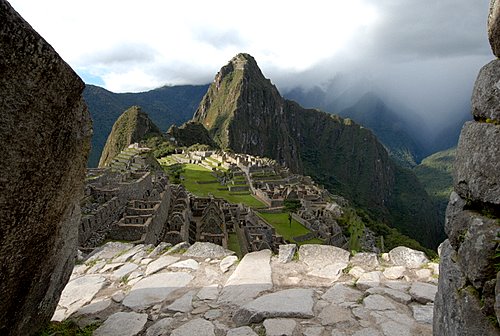
The Lost City of the Incas, Machu Picchu
For many visitors to South America, one of their primary goals is to visit the Lost City of the Incas – also known as Machu Picchu. I too was very keen to see the hidden city perched high amongst the Andean cloud forest and so I ensured I gave myself a day or two to visit South America’s most famous archaeological site. I am not much of an historian, so I was a little surprised to learn that the Incan Empire was relatively short-lived (about 1440 to 1532) and also in a time period more recent than I had imagined. Being a curious sort… I wanted to find out what else was happening on the planet when the Incas were in their prime so I did a bit of research. Some key world events that occurred during the height of the Incan Empire in South America include the following (selected from the World History website at http://timelines.ws):
c1440: Leif Eriksson drew a map of America about this time.
1451: Christopher Columbus, was born in Genoa.
1452: Apr 15, Leonardo da Vinci, Italian painter, sculptor, scientist and visionary, was born in Vinci near Florence.
1457: King James II of Scotland (James of the Fiery Face) banned "Futeball" on the grounds that it threatened national defense by drawing young men away from archery practice. He banned "Golfe" for the same reason.
1460-1470: Machu Pichu was built under the Inca King Pachacuti in the Peruvian Andes. It was occupied for about 50 years before 180 Spanish conquistadors wiped out a 40,000-man Inca army.
c1470: The Quechua-speaking Incas came to dominate what is now Bolivia a mere 75 years before the Spaniards arrived.
1473: The astronomer Copernicus (1473-1543) was born in Torun, Poland. It was Copernicus who spread the theory that the earth and the planets move around the sun (a very new and controversial idea at that time).
1473: The game of golf was played in Scotland at the old course at St. Andrews.
1475: British fishermen lost access to fishing grounds off Iceland due to a war in Europe. The cod catch did not go down and it is presumed that they had discovered the cod-rich waters off Newfoundland, whose discovery was later attributed to John Cabot.
1480: The Spanish Inquisition was introduced by King Ferdinand and Queen Isabella of Spain.
1491: Henry VIII, King of England (1509-1547) and founder of the Church of England, was born at Greenwich.
1492: Christopher Columbus, set sail from the port of Palos, in southern Spain and headed for Cipangu, i.e. Japan. The voyage took him to the present-day Americas. His squadron consisted of three small ships, the Santa Maria, the Pinta, and the Nina.
1492: Nov 15, Christopher Columbus noted the 1st recorded reference to tobacco.
1492: Leonardo da Vinci drew a flying machine.
1493: Jan 9, Christopher Columbus 1st sighted manatees.
1494: The earliest report of Scots making whiskey was made.
c1495: The 500-year-old body of a young Inca girl was found frozen near the summit of Mt. Ampato, Peru, by American archeologist Johan Reinhard in 1995.
1495-1498: Leonardo da Vinci worked on "The Last Supper" in Milan under commission for Duke Ludovico Sforza.
1496: English King Henry VII hired John Cabot (Giovanni Caboto) to explore.
1496-1497: Michelangelo sculpted "Bacchus," considered his first masterpiece.
1497: Jun 24, Italian explorer John Cabot (1450-1498?), (aka Giovanni Caboto), on a voyage for England, landed in North America on what is now Newfoundland or the northern Cape Breton Island in Canada. He claimed the new land for King Henry VII. He documented the abundance of fish off the Grand Banks from Cape Cod to Labrador.
1497: In Scotland the Declaration of Education Act required children to go to school.
1498: Toothbrush was invented. In China the first toothbrushes with hog bristles began to show up. Hog bristle brushes remained the best until the invention of nylon.
1503: Leonardo Da Vinci began painting the "Mona Lisa."
1509: Henry VIII was crowned king of England.
1510: Sunflowers from America were introduced by the Spaniards into Europe.
1512: Michelangelo's paintings on the ceiling of the Sistine Chapel were completed and first exhibited to the public.
1512: Newfoundland cod banks were exploited by fisherman from England, France, Portugal and Holland, who sent the dried catch back to Europe.
1515: Spanish conquistadores founded Havana, Cuba.
1516: The first published account of the discovery of North America appeared in "De Rebus Oceanicus et Novo Orbe" by the Italian historian Peter Martyr.
1520: Portuguese navigator Ferdinand Magellan reached the Pacific Ocean after passing through the South American strait, the straits of Magellan and entered the "Sea of the South." He was first European explorer to reach the Pacific Ocean from the Atlantic by sailing through the dangerous straits below South America that now bear his name.
1523: Sugar was grown in Cuba for the first time.
1531: Haley’s comet caused panic in many parts of the world.
1532: Spanish conquistadores reached the high valley of the Andes. Pizzaro entered Cuzco, Inca capital of Peru.
1534: Jacques Cartier reached Newfoundland, discovered Prince Edward island and became the first man to sail into the mouth of the St. Lawrence River.
So while Michelangelo and Leonardo da Vinci were creating masterpieces in Europe, and Scots were sipping on whiskey while playing a round of golf at St. Andrews and while explorers such as Christopher Columbus and John Cabot were exploring new worlds, the Inca were expanding their South American empire. From their main stronghold at present day Cusco (also spelled Cuzco) the Inca built trails that connected their Andean centres north through Ecuador to Colombia, south to Chile and Argentina, westward to the Pacific Ocean and eastward into the jungles of no return – the mighty Amazon basin. And yet, with the arrival of the Spanish conquistadors, the less than 100 year dominance of the Incas… ended quickly. On August 28, 1533, Atahualpa, the last of the Inca rulers was executed by order of Spanish conquistador Francisco Pizarro. The Inca empire died with him.
Cusco to Machu Picchu Train
From Ollantaytambo, I joined one of the three or four daily trains that connect Cusco with Aguas Calientes, the town at the base of Machu Picchu. It was an amazing ride on a comfortable modern train (filled with tourists… not just from outside Peru, but with many Peruvians as well!). The train followed the valley of the Urubamba River and as we got closer to Machu Picchu the landscape changed with every curve of the tracks… the patterned patch-work of agricultural lands were slowly replaced by spectacular native forest on the steep valley walls. I even caught glimpses of small flocks of parrots cruising above the canopy as well as ducks in the river (likely torrent ducks). The mighty Urubamba was raging which just emphasized again that during the wet season it is not to be messed with!
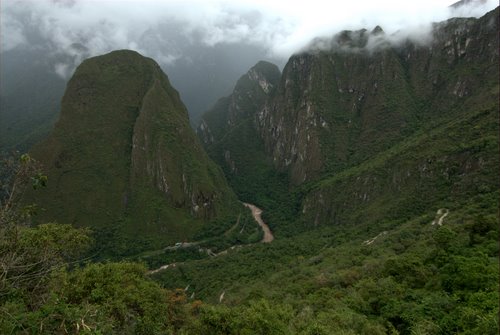
Steep Valley Walls of the Urubamba River
With a full train of tourists and at least two other full train loads of tourists already in Aguas Calientes ahead of me… as well as hundreds of hikers arriving at Macchu Pichu via the Inca Trail each day, I was quite curious to experience how the logistics worked for the actual visit to the archaeological site because the number of visitors per day is staggering… over 2000 people per day!
When the train pulled in to Aguas Calientes there was a chaotic yet somewhat organized process to get yourself from the train station and onto a bus up to Machu Picchu. The best thing to do is simply follow everyone else. Once you leave the station, there are a couple of dozen ‘hostal or hotel’ representatives waiting for your luggage (which you entrust to them) and continue en masse along the cattle track (ensuring to hang on tight to your camera gear). You then make your way through a maze of trinket and textile sellers to get on one of the non-stop busses that weave their way up the 8 km of road uphill to the site. I had not done much research and was worried that I might miss ‘my bus’… but alas, that is not an issue. Each bus leaves when full, and you simply get in line, show your ticket and away you go. At the top of the switch-backed road you get off and wait to hear your name being called (if you booked a tour) and then get in line with the other folks and your guide takes over from there. If you go without a guide you may miss some of the fascinating history of Machu Picchu unless of course you bring a field guide along with you (and there are many of those… so you can make your choice accordingly).
I had the good fortune of seeing Machu Picchu in rain, sun and fog. It is a place you just have to see for yourself.
Machu Picchu in Rain
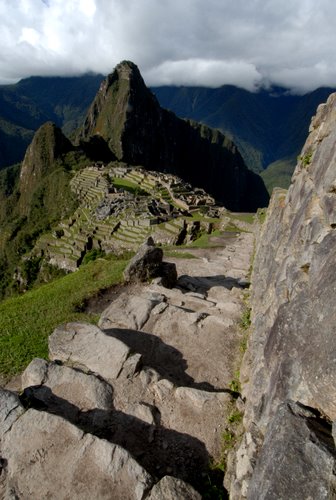
Machu Picchu in Sun
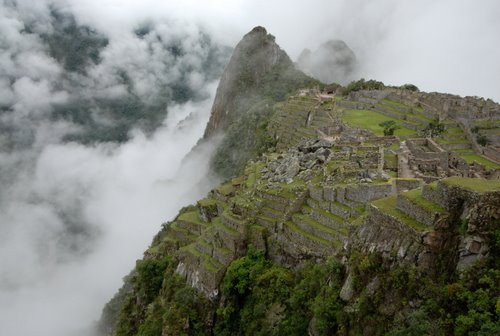
Machu Picchu in Fog
It's astonishing !!!!!!!Can't say any word about it! are you a photogrpher..(Lol)
Samira
Hello Daniel,
Read about your trip on the SFU AQ news site. Thought I'd stop by and take a look.The pictures are beautiful. It's an interesting concept - seeing and learning about places anew through your lens. There is indeed a difference between reading about distant places from a book written sometime ago and reading a travel account documented as it unfolds... Its like travelling with the narrator. Ah the gifts of technology! the possibilities are indeed endless....
cheersShaminaYo Danny
I would like a lot of new blogs!

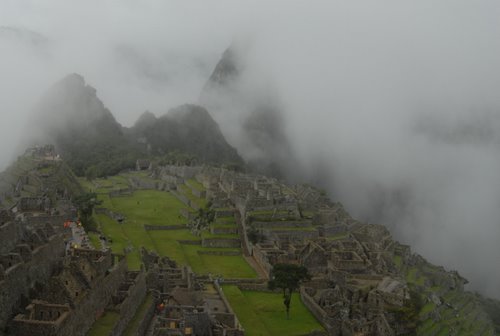
 Funded by TEK
Funded by TEK
Thank you, Danny for the history lesson. Some of those things I knew, but some I absolutely did not.
And the photographs are to die for. Stunning landscapes, subjects, and perspective!
Great job!
Terry